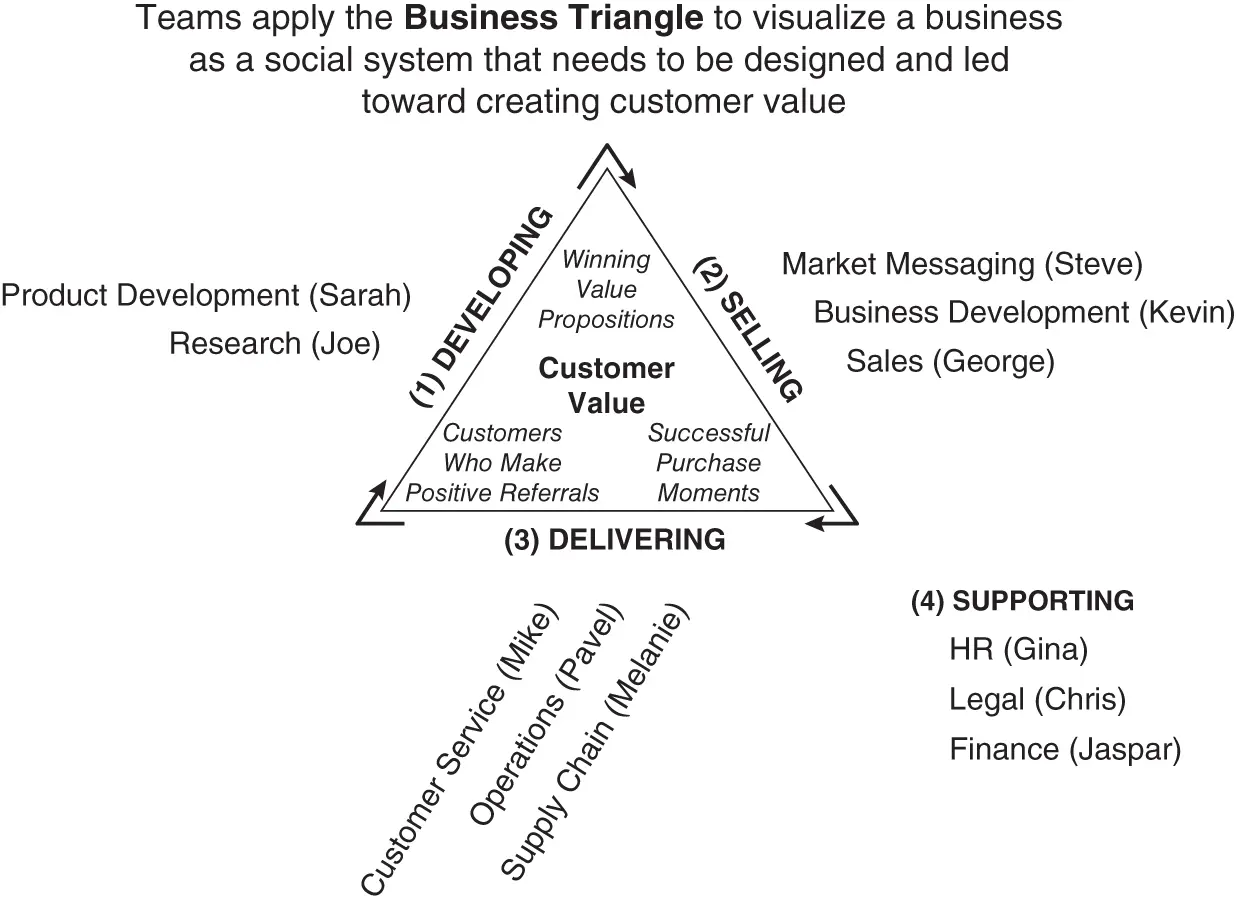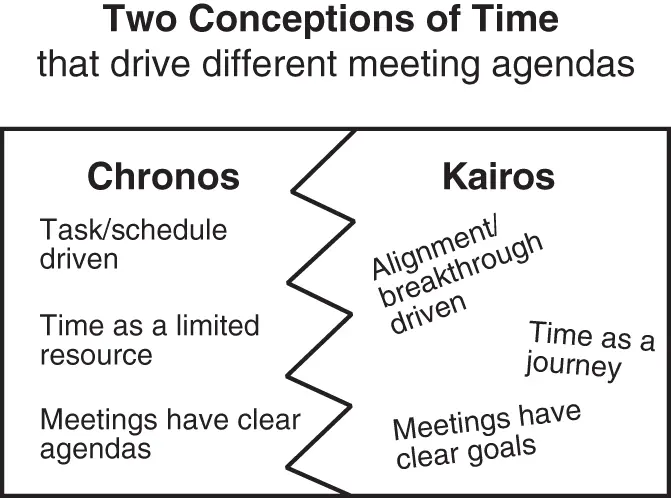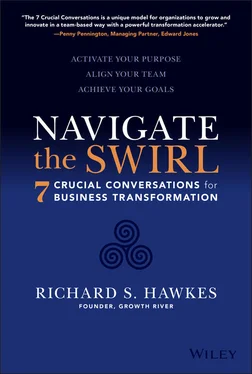Develop-Sell-Deliver —three sides of any business activity. Together, those capabilities make up the basic elements of any workflow. Support , I realized, was something else entirely. Functions like accounting, IT, or HR, are not directly responsible for the customer experience. Rather, they are responsible for economies of scale within the business. In that sense, they “support” the business, and are best represented as a circle around the triangle.
Businessrefers to a system of capabilities and roles designed and managed to develop, sell, deliver, and support products and services to target customers toward competitive advantage. The Business Triangle is a way to visualize this definition.
Business capabilitiesare strategic factors critical to creating value in a business or for a customer. Capabilities answer the question, “What do we need to have in place to execute our strategy?”
Rolerefers to the function, responsibilities, and accountabilities assumed by a person or a team in a particular situation, scenario, or system.
The Business Triangle provides business teams with an approach to visualize and discuss operating models and organizational structures, which are the place where most company transformations fail. When you visualize and map processes with your team, and use those visualizations to define and organize shared work, you are creating shared language. And, that shared language will enable you and your teammates to accelerate crucial conversations, which will enable your team and company to become high performing. People are able to negotiate how, why, and for what purpose they will interact. We should never underestimate, in business or in life, the power of creating an authentic sense that “we're in this together.”
The Business Triangleis applied by business teams to visualize the business social system, which includes the flow and interdependencies of capabilities and roles in companies that constitute a business. In Figure 2.2, you can see a simplified example. The capabilities and roles are roughly in sequence of the flow of value around the sides—a discussion that often generates insights. Next to each capability is the name of the business team member who is playing that role, and as such, is responsible for managing and continuously improving those capabilities. Of course, each business will vary a little when it comes to the specific capabilities and roles that populate each side of the triangle.

FIGURE 2.2 Example of the Business Triangle
In the Business Triangle for a startup company, the leader's name may show up multiple times against capabilities and roles, because they essentially do everything—develop, sell, deliver, and support! But as the business grows, this changes. In a small to medium-sized business, there may be several people working on each side of the triangle. In a large business, there are likely to be multiple triangles, representing the many business segments or models within the enterprise.
Kairos and Chronos Balance—Time to Work In and On
In high-performing business teams, members plan and make time to work both in and on the team and business. They are good at focusing on tasks to be done but are also good at taking time to step back and reflect on progress. They manage a good balance between Chronos and Kairos time.
We can describe two types of conversations and meeting agendas, using the two Greek words for time: Chronos and Kairos (see Figure 2.3).

FIGURE 2.3 Chronos and Kairos
Chronos refers to thinking about time as a limited resource that is allocated to tasks and constrained by resources. Chronos meetings have clear agendas and a tight schedule so that everything can be covered.
Kairos, on the other hand, is what happens when we immerse ourselves in crucial conversations around goals and realities. Participants work together, helping each other process complex topics and accelerate thinking. They study, listen, sense, design, choose, align, all following the conversational landscape together. Complex topics can require multiple Kairos meetings, with breaks between, to arrive at a breakthrough, reach a decision, and align a commitment.
Every team needs a healthy balance between Chronos and Kairos. If you spend too much time on Chronos, you'll never grow and scale a company. On the other hand, if you spend too much time in Kairos, you'll never grow and scale a company.
I have been amazed to see the power of the Business Triangle to effectively cut through the seeming complexity of a large enterprise, clarifying the confusion of roles, sorting out overlapping responsibilities, and revealing essential interdependencies. This, in turn, helps catalyze the right conversations to create clarity and alignment. Over time, I've only come to appreciate the power of this model more deeply—in small, medium, and large organizations. In later chapters, I will show how the natural creative tensions between the different sides of the triangle, often a source of crippling conflict, can be leveraged as a source of innovation. It's rare that I work with a business with which, sooner or later, there isn't a significant “aha” moment when the business team realizes how truly tangled its system of capabilities and roles is, which is fueling the Swirl and stymying growth.
The Business Triangle is like the engine of a business. It works best when everything is flowing smoothly around the various functions from Develop to Sell to Deliver without major blockages or confusion. Value creation flows from the original conception and creation of the product or service all the way to the customer, and then there is a feedback chain, coming back from the customer into the Develop part of the business. And around the triangle we go (see Figure 2.4). Meanwhile, our support functions are doing just that—supporting. And the customer is always in sight.

FIGURE 2.4 The Business Triangle in Action
Indeed, the Business Triangle provides a model of the business that always keeps serving the target customer's needs as a core objective, and aligning the business social system to work interdependently as the solution path. It sounds simple, but in practice, most organizations struggle to identify problems and resolve gaps in their system of roles fast enough to keep up with the needs of an evolving business. When we have the Business Triangle as a simple, shared language with which to discuss who the target customer is for each type of business capability, and what roles are going to own those capabilities, it becomes so much easier to shorten the distance between a problem or a breakdown and an elegant solution and resolution.
And, perhaps most importantly, the Business Triangle provides a model for organizing and growing a business that engages the social system and respects people's natural agency. It doesn't try to slot people into a mechanistic process; it allows them to see what they are in together and negotiate their roles within that system. This is essential for successfully navigating the difficult org structure conversations that come up in (and too often derail) any transformational journey. It provides an empowering and liberating shared language that clarifies priorities and reveals possibilities for optimizing how your business creates value as a team. It's visually clarifying. It boils the essential elements of your business down to a system of capabilities and roles, which then sets the stage for mapping and managing all the critical activities in a business through clear accountabilities. In sum, it allows us to model the seeming complexity of everything that goes on in a business. Throughout the journey of growth that we'll be exploring in this book, this model will be an essential tool. It doesn't capture everything about the nature of an organization or enterprise but it is a critical element in the shared language we are developing. As we bring clarity and transparency to the social system of an organization, the confusion of the Swirl recedes, and we set the stage for the crucial conversations that follow.
Читать дальше















